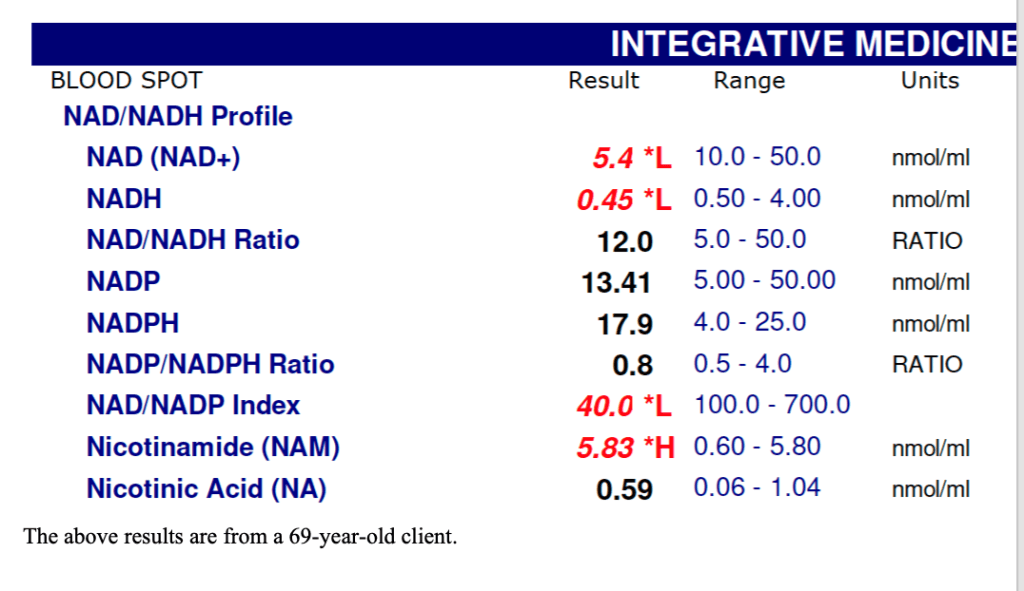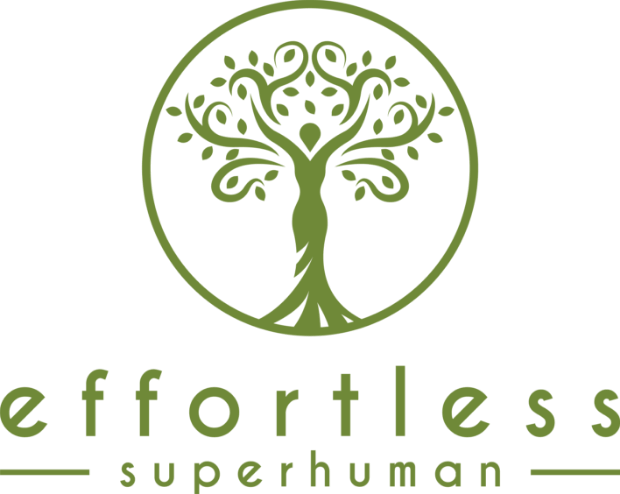 Recently, there has been considerable buzz surrounding NAD+ and its potential to slow down the aging process and extend lifespan. But beyond the longevity hype, there’s a deeper story worth exploring – one that could have important implications for healing from illness, chronic pain, and musculoskeletal injuries.
Recently, there has been considerable buzz surrounding NAD+ and its potential to slow down the aging process and extend lifespan. But beyond the longevity hype, there’s a deeper story worth exploring – one that could have important implications for healing from illness, chronic pain, and musculoskeletal injuries.
NAD+ (short for Nicotinamide Adenine Dinucleotide) is a coenzyme found in every body cell. It plays a central role in energy metabolism, acting as a crucial electron carrier in key processes such as glycolysis, the citric acid cycle, and oxidative phosphorylation. In simple terms, NAD+ helps your cells turn nutrients into usable energy (ATP), which is essential for life.
But its role doesn’t stop there.
NAD+ is also involved in a range of cellular repair and maintenance functions. It supports DNA repair, regulates gene expression, and activates important enzymes, like sirtuins and PARPs, both of which are heavily involved in cellular health, inflammation control, and longevity. Unfortunately, NAD+ levels naturally decline with age and may also be depleted by stress, poor diet, alcohol, and illness.
This is where NAD+ boosters come in. Supplements like nicotinamide mononucleotide (NMN) and nicotinamide riboside (NR) have been studied for their ability to raise NAD+ levels and support the body’s natural repair mechanisms.
So the real question becomes: could boosting NAD+ be a valuable tool not only for slowing the aging process, but also for accelerating recovery from injury, reducing inflammation, and supporting long-term healing?
It’s a question worth asking, and one that may open up exciting possibilities in the world of health and rehabilitation.
The Impact of Aging and Lifestyle on NAD+ Levels
One key challenge with NAD+ is that it naturally declines as we age. Research has shown that levels drop significantly in various tissues over time. This decline is partly due to the reduced activity of NAMPT, an enzyme critical for NAD+ synthesis, and increased consumption of NAD+ by repair enzymes, such as sirtuins and PARPs.
As the levels fall, so too does the body’s capacity for mitochondrial function, cellular energy production, and DNA repair. In fact, a 2016 study published in Cell Metabolism found that NAD+ levels in human skin tissue decrease markedly with age, mirroring a decline in cellular performance and resilience.
But aging isn’t the only factor.
A wide range of lifestyle factors and health conditions may further deplete NAD+, making the picture even more complex. Chronic stress, poor dietary choices, alcohol overuse, and environmental exposures all place additional strain on the body’s NAD+ reserves.
More specifically, low levels have been associated with:
- Heavy metal toxicity
- Mould exposure
- Chronic stress and inflammation
- Gut dysbiosis
- Nutrient-poor diets
- Low levels of key nutrients like vitamin D, vitamin C, and essential minerals
- Anaemia and other underlying deficiencies
In other words, NAD+ depletion is not just a product of aging – it’s also a reflection of how our bodies are coping (or struggling) with the demands of modern life.
The good news is that understanding these contributing factors opens the door to strategies that may help restore balance and rebuild cellular vitality. One strategy may be supporting NAD+ levels through targeted lifestyle interventions and supplementation.
Signs You Might Have Low NAD Levels
NAD is a vital molecule found in every cell of the body. When NAD levels drop, they could throw several body systems out of balance. The tricky part? Low NAD levels don’t always cause noticeable symptoms. Instead, you might notice subtle changes that are easy to brush off or confuse with other issues.
Here are some symptoms to look out for:
- Low Energy or Fatigue – Feeling constantly tired, even after a good night’s sleep? NAD is key to energy production in your cells, so when levels drop, it can leave you feeling flat and sluggish.
- Brain Fog or Trouble Concentrating – NAD supports brain cell health and repair. Low levels can contribute to poor focus, memory lapses, and a general sense of mental fuzziness.
- Muscle Weakness or Soreness – Your muscles rely on efficient energy production to function well. Low NAD levels might manifest as weakness, cramps, or unusual soreness, especially after physical activity.
- Poor Exercise Endurance – Struggling to keep up with your workouts or tiring quickly? Low NAD can impact how well your body produces and uses energy during physical activity.
- Skin Changes – NAD plays a role in repairing skin cells and maintaining a healthy complexion. You may notice that your skin appears dull, dry, more sensitive, or exhibits signs of early aging, such as wrinkles.
- Sleep Problems – NAD helps regulate your circadian rhythm – the body’s internal clock. Disrupted NAD levels may lead to trouble falling asleep, staying asleep, or feeling rested in the morning.
- Mood Swings or Low Mood – NAD is involved in creating and regulating neurotransmitters (your brain’s chemical messengers). Low levels may affect mood, increasing irritability, anxiety, or even symptoms of depression.
- Getting Sick More Often – If your immune system seems weaker than usual, you experience more frequent colds, or you recover from illness more slowly, low NAD could be part of the puzzle, as it plays a key role in immune cell function.
- Changes in Metabolism or Weight – NAD helps control how your body processes glucose and fats. Low levels might show up as weight gain, difficulty losing weight, blood sugar fluctuations, or signs of metabolic syndrome.
- Signs of Early or Accelerated Aging – Because NAD is essential for repairing damage in your cells, a drop in levels can lead to faster signs of aging – things like joint stiffness, reduced skin elasticity, and slower recovery from injuries.
These symptoms are often subtle and may overlap with many other conditions. However, if you notice several of them, especially as you age or after periods of stress or illness, it may be worth exploring ways to support and restore your NAD levels.
Can You Test Your NAD Levels?
Yes, you can! Thanks to advanced lab testing, you can now check your NAD levels and get a clear picture of your starting point. This kind of baseline testing could help guide your treatment plan and monitor progress over time.
For example, the results below are from a 69-year-old client who was experiencing fatigue, poor muscle recovery, and joint stiffness. The test confirmed low NAD levels, helping us better understand what was driving his symptoms.

Low NAD and Musculoskeletal Health
More and more research points to a strong link between low NAD levels and musculoskeletal issues – problems with your muscles, bones, joints, and tendons. Here’s how it all connects:
Muscle Function and Recovery
NAD is essential for your mitochondria – the energy factories in your cells – to do their job. It also helps to repair and maintain muscle tissue. When NAD is low, your muscles may not recover properly after activity, and over time, this can contribute to issues like muscle loss (sarcopenia) or general weakness. In some studies, low NAD has even been shown to interfere with the body’s ability to regenerate muscle after injury.
Inflammation and Joint Damage
Without enough NAD, your body struggles to manage inflammation and repair DNA damage. This could lead to increased oxidative stress – a kind of internal “rusting” – that contributes to joint issues like osteoarthritis or rheumatoid arthritis. Chronic inflammation wears down cartilage and soft tissue over time.
Aging and Tissue Breakdown
As NAD levels decline as we get older, this is now being linked to a higher risk of common age-related conditions, such as osteopenia, osteoporosis, and cartilage degeneration. In other words, less NAD = more wear and tear.
What Does the Research Say?
While much of the research is still in its early stages, especially in humans, animal studies have shown some impressive results. Boosting NAD levels with supplements like NMN or NR has been shown to enhance muscle repair and strength, reduce joint inflammation, support better bone density, and accelerate recovery after muscle injury.
Some specific areas being explored include:
- Osteopenia and Osteoporosis
- Bone healing and regeneration
- Osteoarthritis
- Tendinopathy (tendon pain and injury)
- Muscle tears and recovery
- Faster muscle regeneration with age
While the research is still unfolding, it’s an exciting and promising area. If you’re struggling with slow recovery, chronic joint pain, or age-related muscle loss, supporting your NAD levels might be an important piece of the puzzle.
How to Boost Your NAD Levels
If your NAD levels are low or you’re just looking to support healthy aging and recovery, several evidence-based ways exist to boost them. Some strategies are simple lifestyle tweaks, while others involve targeted supplementation.
Let’s break it down for you:
1. Supplementing with NAD Precursors
These are the building blocks your body uses to make more NAD:
- NMN (Nicotinamide Mononucleotide) – This is one of the most direct ways to boost NAD. Studies suggest taking 250-500 mg per day can be effective.
- NR (Nicotinamide Riboside) – Another popular option, usually taken at 250-500 mg daily. Research shows it reliably raises NAD levels in the blood.
- NAD Injections (Subcutaneous) – These involve injecting a small amount of NAD under the skin, usually 50 to 100 mg, 2-3 times per week.
- IV NAD Therapy – This is often the most effective method in terms of absorption, delivering 500 to 750 mg per session straight into the bloodstream.
💡 The right dose really depends on your individual needs and the results of your NAD test. The goal is to find the lowest effective dose, and testing helps guide that process.
2. Supporting NAD Naturally Through Food & Lifestyle
These everyday habits help support your body’s ability to make and protect NAD:
- Eat NAD-boosting foods - Include more dairy, fish (like salmon and tuna), poultry, mushrooms, and whole grains. These are rich in niacin and tryptophan, nutrients your body converts into NAD.
- Add fermented foods – Kombucha, miso, kimchi, and sauerkraut, support gut health. This can help your body absorb and produce nutrients more efficiently, including those that support NAD.
- Exercise regularly – Both aerobic and strength training stimulate an enzyme called NAMPT, which helps build NAD. Aim for at least 150 minutes of moderate activity a week.
- Try intermittent fasting or reducing calories occasionally – Cutting calories by 20-30% or following a time-restricted eating window (like the 16:8 method) may activate sirtuins. These proteins depend on NAD to help increase their production.
- Limit NAD-depleting habits – Alcohol, smoking, chronic stress, and poor sleep all deplete NAD. Reducing these can help conserve what your body naturally produces.
- Get quality sleep – Good sleep supports your body’s natural circadian rhythm, which is closely tied to NAD production.
3. Consider Key Nutrients & Plant Compounds
Some natural compounds, such as resveratrol, found in red grapes, berries, and red wine, may help your body produce more NAD or prevent it from being broken down. It can also help activate sirtuins, proteins that rely on NAD to function. Supplements are also available.
Apigenin, found in parsley, chamomile, and celery, may help by blocking CD38, an enzyme that breaks down NAD.
The bottom line? There are multiple ways to support healthy NAD levels, including supplements and IVs, as well as diet and lifestyle choices. If you’re feeling low in energy, slow to recover, or noticing signs of early aging, boosting your NAD could be an important part of your health plan.
Final Thoughts on NAD+ and Its Benefits
When it comes to health and healing, there’s simply no replacement for getting the foundations right. Supplements like NAD precursors may play a crucial role, but they are most effective when combined with a strong, healthy lifestyle.
At our clinic, we focus on what we call the Foundation Principles of Health, because without these in place, long-term healing is nearly impossible:
- Mental, emotional, spiritual, and physical well-being
- Quality sleep and oxygen saturation overnight
- Proper hydration and clean water
- Nutritious food and optimal gut health
- Daily movement, strength training, and VO2 max work
- Stress management and inflammation control
Factors That Cause NAD Levels to Drop
Recognising the underlying causes of low NAD is key to understanding the bigger picture. Many common health challenges can quietly deplete NAD over time: chronic stress and inflammation, regular alcohol use, poor sleep or sleep apnea, nutrient deficiencies (e.g., vitamin C, D, B12, folate), heavy metal or mould exposure, gut dysfunction (like dysbiosis or leaky gut), genetic factors like MTHFR mutations, anaemia and other metabolic issues.
That’s why, before beginning treatment, we start with a detailed review of your lifestyle and health history. From there, we may recommend testing, such as stool analysis, blood panels, NAD testing, Omega-3 levels, or heavy metal screening, to get a clearer picture of what your body needs.
What We’re Seeing in the Clinic
The results of optimising NAD levels, especially when guided by testing, have been a game-changer for many of our clients. We’ve seen improvements in conditions like chronic pain and tendinopathy, brain fog and neurological symptoms, osteoporosis, osteoarthritis, spinal issues, autoimmune conditions like rheumatoid arthritis and ankylosing spondylitis, headaches and migraines, disc injuries, meniscal and labral tears, plantar fasciitis, and more.
Where We’re Headed: What the Future Holds
We’re still only beginning to understand the full impact NAD has on health, healing, and longevity. But early results are incredibly promising, both in the research and right here in the clinic.
With thoughtful testing, targeted support, and a strong foundation of health, maintaining optimal NAD levels may be one of the best strategies we have for ageing well, healing deeply, and staying vital throughout the lifespan.
If you’re curious about where your NAD levels sit or how this might fit into your broader healing journey, we’d be happy to explore it with you.
